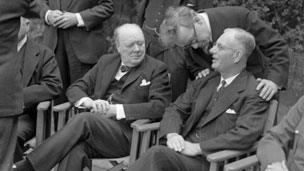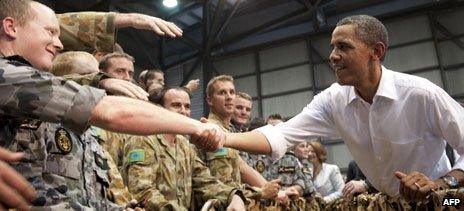Darwin, 1942: Remembering Australia's 'Pearl Harbor'
- Published
Duncan Kennedy meets survivors of the attack on Darwin
It's 70 years since Japanese bombers swooped on Darwin, in northern Australia, sinking Allied ships in the harbour and killing hundreds of people. For years the attack was rarely mentioned, but now the story is finally being told.
If 7 December 1941 is "a date that will live in infamy" for the United States, then 19 February 1942 is surely one that will join it in the annals of shame for Australia.
That was the day, just 10 weeks after the attack on Pearl Harbor, when the same carrier-based Japanese force turned its attention to the small northern town of Darwin, with equally calamitous results.
But the world remembers one and barely recalls the other.
The seven-volume Official History of the Australian Army in World War II devotes only two pages to the attack on Darwin.
Yet in truth, Darwin was Australia's Pearl Harbor - a morning attack carried out on an unsuspecting population that ended with the deaths of hundreds of people and the sinking of numerous Allied ships.
But it's only now that the story of Darwin has been given the same kind of historical attention that's long been focused on the attack on Hawaii.
There are many reasons for this. Chief among them are that:
it happened just three months after Pearl Harbor and was overshadowed by it
communications out of Darwin were poor and it took time for the news to filter out
the Australian authorities played it down, for fear of provoking national panic
On the day itself, the first wave of Japanese bombers was spotted over an island north of Darwin half an hour before the attack, but they were mistaken for American Kittyhawks.
It wasn't until a few seconds before they dropped their bombs that the first siren in Darwin was sounded, and this delay added to the casualty toll.
Over the next 40 minutes or so, some 188 Japanese aircraft strafed the docks, ships and surrounding town.
"We could see the red dots on the side of the aircraft, they were so low," says Margaret Herron, an 11-year-old girl at the time.
"We thought they were dropping silver bells, until we realised they were bombs. I was terrified and ran to shelter in a quarry."
Another deadly wave then followed.
By the time the Japanese left, eight ships had been sunk - including the American destroyer, the USS Peary - 22 aircraft destroyed, dozens of buildings crushed and more than 240 people killed.
It was the worst wartime loss of life on Australian soil in the country's history.
More than 60 other aerial bombardments would follow, up until November 1943, but none as destructive as the first.
"It was a disaster," says Dr Tom Lewis, a historian and director of the new $12m (£7.6m) Darwin Military Museum.
"Australians had been fighting in Europe and the Far East, but now the war had come to us. We had never experienced anything like it."
What followed next helped account for the raid's absence in the Australian consciousness for decades to come.
First, Darwin had no telephones. This frontier town, of about 4,000 people at the extremities of a vast continent, had to rely on the telegraph to make contact with the outside world, so news of the attack was fragmented and inconsistent.
Second, there was a panicky response by the population and by some in the military, with an unseemly scramble to get away, for fear of a Japanese invasion.
Third, there was a shocking lack of leadership among the civilian administration and the military, which compounded the sense of chaos and incompetence.
It was a somewhat ignoble record - one that not everyone wanted to see in the history books.
A sense of partial anarchy prevailed in the hours and days immediately after the raid.

PM John Curtin (pictured right, in 1944) was in hospital at the time of the Darwin raid
For example, the station commander of the Royal Australian Air Force (RAAF) ordered his men to rendezvous in the bush, but as the instruction was passed around by word of mouth, its message became confused.
Four days after the bombing, nearly 300 RAAF personnel were still missing, leading to claims some had deserted. One man turned up in Melbourne, 13 days later.
The Northern Territories administrator, Aubrey Abbott, appeared to compound the problems by his ineptitude.
In an acclaimed book on the Darwin bombing, An Awkward Truth, Peter Grose writes that Abbott tried to enlist the help of military police to restore order, but that they ended up drunk and took part in the looting that followed the attacks.
Abbott himself spent his time securing his drinks cellar and making sure the bank's money was sent away for safe keeping - a strange set of priorities for a man whose town was in ruins.
However, unlike many, he did, a least, stay at his post, remaining for another 12 days after the assault.
One of the few other laudable responses to the raid had come from the gunners who'd tried to repel the Japanese onslaught, though their meagre munitions made them no match for their aerial opponents.
The federal government in Canberra was stunned by the attack, and withheld the number of fatalities for some time.
Author and blogger Lisa Hill says: "This was partly because of the confusion and partly because of misguided censorship. There were fears about public alarm and concern about awkward questions being raised about the adequacy of Australia's defences."
It didn't help that Prime Minister John Curtin was being treated in hospital for exhaustion, or that the cabinet was squabbling over where to send Australian troops in the aftermath of the fall of Singapore, which had taken place four days earlier.
So, with all the dithering, failure of leadership and generally embarrassing response to what was clearly a pre-existing Japanese threat to the strategically important harbour at Darwin in the weeks following Pearl Harbor, it's perhaps not surprising that history has been unkind to its suffering and loss.
Today, though, that is changing.
As well as the new museum, a memorial stone has been built by the quayside, bearing the names of some of the dead and recording the heroic deeds of some of the living, all of which helps bring the more illustrious side of the story back to life.
On his visit to Darwin last November, US President Barack Obama reaffirmed the importance of the raid he referred to as Australia's Pearl Harbor.

"Against overwhelming odds, our forces [US and Australian] fought back, with honour and with courage," he said. "The days after Darwin were tough. Some thought Australia might fall. But we dusted ourselves off. We picked ourselves up. We rebuilt."
To emphasise Darwin's renewed relevance, he announced that hundreds of US marines are to be stationed there, implicitly underlining the current American concern with China.
The aftermath of the Darwin attack might not have covered Australians in glory and dignity.
But that's no reason not to remember the day itself, when, like Pearl Harbor, Darwin's skies were darkened by the menacing presence of an unforgiving enemy.